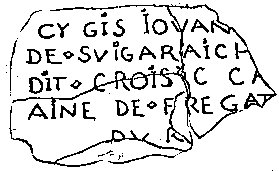
In an old cemetery at Placentia several tombstones were found with Basque inscriptions. These relics of a race from the northern slopes of the Pyrenees are unique on the continent of America. They are reminders of Basque visits to the shores of Newfoundland. After Utrecht when settlers of English and Irish blood came to Placentia, many old gravestones were removed from the ancient cemetery to serve as doorsteps. Within recent years the few remaining have been placed in the little Anglican Church for observation. They are now on display at Castle Hill Historic Site and O'Reilly Heritage House, Placentia.
There are altogether five stones or fragments bearing inscriptions. Of these, two are parts of the tablet and are in French, and three are in Basque. Of the latter, one bears the date 1676 and is the oldest tombstone yet discovered.
The piece of stone on display in the Visitor Centre, through written in French, commemorates a Basque privateer who died in 1694.
The remaining text reads :

Fortunately, Archbishop Howley studied the stone over seventy years ago when
it was in better condition. As a result we have a more complete record of the
text.

According to Howley the stone is best translated as:
HERE LIES JOUANNES DE SVIGARAICHIPI DIT CROISIC CAPTAIN OF THE FRIGATES OF THE KING, ENVIEUX. FOR THE HONOUR OF MONSIEUR LE PRINCE I WENT, IN FOLLOWING HIS CAREER TO ATTACK THE ENEMY EVEN IN THEIR OWN---.
Svigaraichipi, a privateer from the town of Le
Croisic was commissioned by the French government to attack enemy commercial
shipping. Due to his success against the English, Dutch and Spanish, King
Louis XIV appointed him to the rank of Captain de Fregate. How he died
is not known but he was possibly in Newfoundland to protect the annual
fishing convoy.